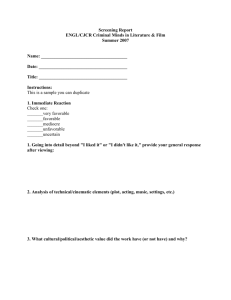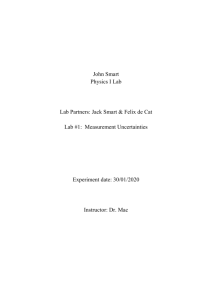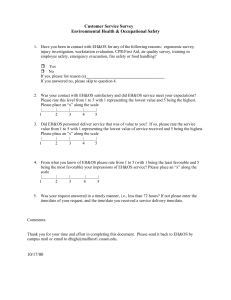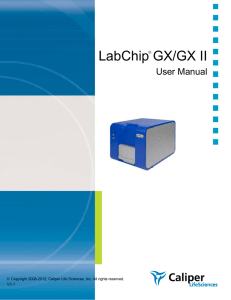Marketing Planning for Caliper Technologies’ Labchips
advertisement
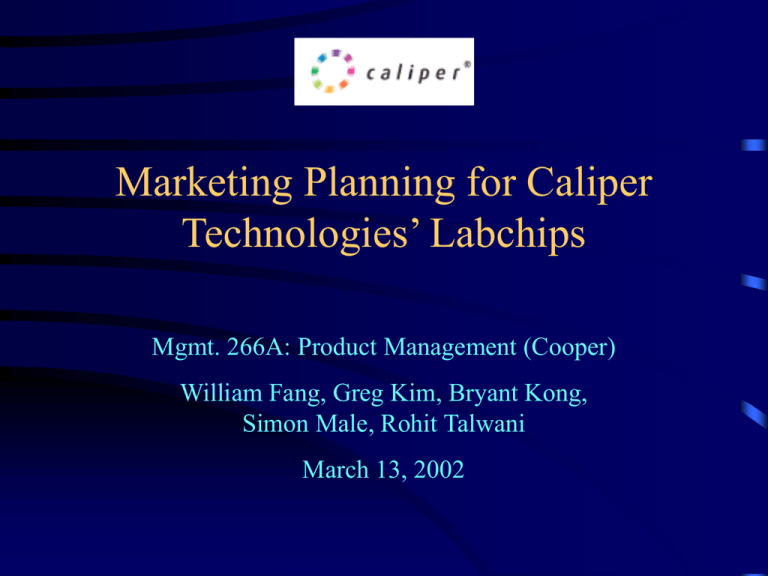
Marketing Planning for Caliper Technologies’ Labchips Mgmt. 266A: Product Management (Cooper) William Fang, Greg Kim, Bryant Kong, Simon Male, Rohit Talwani March 13, 2002 Planning Objective To determine the likelihood of various levels of revenue growth for Caliper Technologies’ labchip product line over the coming year. 2 Agenda • • • • • • • • • • What Are Labchips? Caliper Technologies Market Overview Critical Issues Hugin Network Probabilities Results and Decision Nodes Sensitivity Analysis Recommendations Questions? 3 What Are Labchips? • Labchips are miniature silicon devices used for biomedical applications on a micro-dimensional scale – Use MicroElectroMechanical systems (MEMS) technology • Can reduce duration of experiments by orders of magnitude – Automate previously manual laboratory processes – Require much smaller amounts of sample and reagents • Offer mission-critical benefits to researchers – Faster throughput – Cost savings – Reduced human error 4 Caliper Technologies • Public biotechnology company with $32 M in revenues from two main sources: – Labchips and Agilent analyzer system (est. $19.2 M) – High-throughput screening systems • Labchip systems are used in chemistry, biomedical research, and drug discovery and development – – – – – DNA, RNA, protein, and cell analysis Market leader in labchips Principal strategic partner is Agilent Technologies Uses lead customer programs to identify new product applications Recently settled patent litigation with competitor ACLARA 5 Market Overview • Labchip market estimated at $300 M in 2000 – Projected annual growth rates of 30-40% • Early stages of development – Fragmented competition • • • • Public labchip companies: ACLARA, Cepheid, Nanogen, Orchid Large bioscience players: Applied Biosystems, IBM, Motorola Private companies: Many players Acadamic and government instiutitions: MIT, Dept. of Defense • Significant market trends – Escalating R&D costs, expiring patents drive customer need – Intellectual property battles —» patent litigation or cross-licensing – Lack of technology standards 6 Critical Issues • Derived from preceding market analysis – Also regulatory, manufacturing, social and behavioral issues – Affect research applications or future uses of labchips Political Behav iora l Econo mic Social Technological Caliper Technologies FDA regu lations for device and assay app rova l Foreign regu lations Patent liti gation FDA regu lations for cli nical use Customer process changes (R&D processes, techn icia n training) Access to capit al Pric e Manufa cturing capacit y and cost Complementary produc ts (See Infrastructure ) Product customiz ation Mic ro-scale constraints Business Ecosystem Gove rnment fund ing o f hea lt hcare R&D HMO reim bur sement of medical use s Cross-lic ens ing Escalating R&D costs Expi ring p atents Partner ships wit h e stabli shed companies (Agil ent) (See Infrastructure ) Lack of standa rds Infrastructure Uses fo r protection aga inst bioterrorism Alt ered delivery of medication Desire for non- invasive medical diagno stic procedures Valuation of publi c labchip companies Aging popul ation in industrial nations Protests aga inst gene tic eng inee ring Interoperabilit y with other laboratory devices 7 Hugin Network Internal Economics Demand Produc t Design Competition Customer Need Competition Product Success Major Forces Regulation Regulation 8 Internal Economics • • Technical factors dictate product complexity and manufacturing cost Combined with pricing decision, this determines Caliper’s margins Microdimensional Constraints Problematic Not a Problem Standards Customization High Medium Low Leader Follower Product Design Interoperability Yes No Complex Moderate Simple Manufacturin g Cost Not Costly Costly Very Costly Price Low Medium High Low Medium High Margins Good Acceptable Poor Demand Product Success 9 Demand • • Primary driver of demand is labchips’ ability to meet customer needs Secondary driver of demand is value-based price of product Aging Population Growing Plateauing Process Change Government Funding Significant Medium Insignificant High Medium Low Interoperability Customer Need Yes No Rising Plateauing R&D Cost High Impact Low Impact Patent Expiration High Medium Low Demand Price Low Medium High High Medium Low Product Success 10 Competition • • Patent Litigation Strategic partnerships and cross-licensing determine degree of competition Intense Few Intensity of competition directly impacts Caliper’s margins Strategic Partnership s CrossLicensing Many Moderate Few High Medium Low Competitio n Margin 11 Regulation Can Hinder Growth • Regulation and low access to capital can slow Caliper’s growth Access to Capital FDA Product Success International Regulation Favorable Unfavorable Approval Unfavorable 12 Four Major Forces Impact Product Success Price High Medium Low Demand Access to Capital High Medium Low Competitio n Margin Good Acceptable Poor Product Success Bull Market Bear Market Favorable Unfavorable Regulatio n High Medium Low Utility (Revenues) High Medium Low $ 30.7 M $ 25.0 M $ 21.1 M (60% growth) (30% growth) (10% growth) 13 Estimating Probabilities • Probabilities for starting nodes were straightforward – No other nodes influencing them • Probabilities for nodes with inputs were more difficult. We – Decided the order of strength in which input nodes influence the node – Arranged in ordinal orders each probability set – Determined the graphical behavior of the probability – Assigned probabilities 14 Demand Example Customer Need has a larger influence on Demand. So we ordered each permutation and set the two extreme values. Price CN High Medium Low Low High 0.700 0.200 0.100 Medium High High High Low Medium Medium Medium High Medium Medium Low High Low Low Low 0.000 0.100 0.900 We then determined the graph of the probability appears as follows: 1.000 0.900 0.800 0.700 0.600 0.500 0.400 0.300 0.200 0.100 0.000 1 2 3 4 5 High Medium 6 7 8 9 Low 15 Demand Example continued Then we interpolate the in-between values to complete the table: Price Low Medium High Low Medium High Medium High Low CN High High High Medium Medium Medium Low Low Low High 0.700 0.420 0.189 0.095 0.047 0.043 0.038 0.034 0.000 Medium 0.200 0.374 0.554 0.584 0.551 0.456 0.334 0.201 0.100 Low 0.100 0.206 0.257 0.321 0.401 0.502 0.627 0.765 0.900 16 Results and Decision Nodes • Caliper’s expected labchip revenues are $24.9 M Default High Medium Low Expected % of default 0.291 0.252 0.457 Price High Medium Low Expected % of default High 0.324 0.26 0.416 Customization High Medium Low Expected % of default High 0.298 0.253 0.448 30.7 25.0 21.1 24.9 100.0% 30.7 25.0 21.1 25.2 101.4% 30.7 25.0 21.1 24.9 100.2% Best Case Worst Case High Price Medium Price High Customization Low Customization 0.331 30.7 0.265 30.7 0.261 25.0 0.246 25.0 0.408 21.1 0.49 21.1 25.3 24.6 101.7% 99.0% Medium 0.268 0.247 0.486 Medium 0.289 0.251 0.460 30.7 25.0 21.1 24.7 99.1% 30.7 25.0 21.1 24.9 99.9% Low 0.281 0.149 0.471 Low 0.286 0.251 0.464 30.7 25.0 21.1 22.3 89.6% 30.7 25.0 21.1 24.8 99.9% 17 Sensitivity Analysis Default Undecided High Medium Low Expected Best Case High Customization High Price High Medium Low Expected Worst Case Medium Price Low Customization High Medium Low Expected Product Design Customer Need Decrease favorable Increase favorable Competition Access to Capital Decrease favorable Increase favorable Regulation Increase favorable 0.291 0.252 0.457 30.7 25.0 21.1 24.8764 0.290 0.252 0.458 30.7 25.0 21.1 24.8668 0.293 0.252 0.455 30.7 25.0 21.1 24.8956 0.291 0.252 0.457 30.7 25.0 21.1 24.8764 0.291 0.252 0.457 30.7 25.0 21.1 24.8764 0.2930 0.2524 0.4546 30.7 25.0 21.1 24.8970 0.331 0.261 0.408 30.7 25.0 21.1 25.2955 0.331 0.261 0.408 30.7 25.0 21.1 25.2955 0.333 0.261 0.406 30.7 25.0 21.1 25.3147 0.331 0.261 0.408 30.7 25.0 21.1 25.2955 0.331 0.261 0.408 30.7 25.0 21.1 25.2955 0.334 0.261 0.405 30.7 25.0 21.1 25.3243 0.265 0.246 0.490 30.7 25.0 21.1 24.6245 0.264 0.245 0.491 30.7 25.0 21.1 24.5899 0.281 0.249 0.470 30.7 25.0 21.1 24.7687 0.264 0.245 0.491 30.7 25.0 21.1 24.5899 0.265 0.246 0.490 30.7 25.0 21.1 24.6245 0.266 0.246 0.488 30.7 25.0 21.1 24.6026 Average favorable probability Change % change in favorable probability % change in expected outcome % change in best outcome % change in worst outcome Undecided Best Worst 0.334 (0.010) 0.310 0.010 0.403 (0.010) 0.400 0.010 0.475 0.010 -2.99% 3.23% -2.48% 2.50% 2.11% -0.04% 0.08% 0.00% 0.00% 0.08% 0.00% 0.08% 0.00% 0.00% 0.11% -0.14% 0.0129 0.0000 0.0469 0.59% 0.0239 0.0235 0.1815 -0.14% 0.0000 0.0000 0.0566 0.00% 0.0000 0.0000 0.0000 -0.09% 0.0393 0.0541 -0.0423 18 Recommendations • Caliper should focus on the factors that most strongly influence product success – Build customer demand – Lobby for favorable regulations • Caliper should use its lead customer programs to identify and develop labchip applications that are widely valued in its beachhead market – Risk of building too many customized applications • Could get stuck in early market forever – Need to cross chasm with application that will enable company to dominate pharmaceutical market 19 Questions? 20

